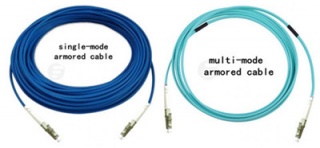Marketing
Three Useful Fiber Patch Cords and Their Use
With the rapid advancement of fiber optic technology and trend towards optical communications, fiber optic patch cord has realized its great use in high speed data transmission networks, found in routers, fiber patch panels, media converters and even in hubs and switches. Compared to its previous counterpart, fiber optic jumper causes lower signal loss, delivers more bandwidth and carries more information, becoming more and more popular in cabling installation or upgrading between or inside buildings. Just like the transceiver modules which fall in many types based on different standards, fiber optic patch cables are also available in several kinds, including single-mode/multi-mode, simplex/duplex, MPO/MTP cable, armored patch cord, and so on. This article aims to introduce the last three useful fiber patch cords and their use.
Simplex/Duplex Patch Cables
Simplex cable, also known as single strand cables, has one fiber, tight-buffered (coated with a 900micron buffer over the primary buffer coating) with Kevlar (aramid fiber) strength members and jacketed for indoor use. The jacket is usually 3mm (1/8 in.) diameter, but some 2mm cable is sometimes used with small form factor connectors. Duplex (zipcord) cable has two fibers joined with a thin web.
Since simplex patch cord consists of only one fiber link, itís used in such applications that only require one-way data transfer. But when the equipment can transmit and receive on two different wavelengths, simplex cable can also be considered. For example, transmit could be at 1310nm and receive could be at 1550nm. This application is found more with single-mode simplex patch cable.
Duplex patch cable is suitable for applications that require simultaneous, bidirectional data transfer. Typical applications include workstations, fiber switches and servers, Ethernet switches, backbone ports, and similar hardware.
MPO/MTP Cable
MPO/MTP cable uses multi-fiber MPO/MTP connectors for setting up high-performance data networks in data centers, so as to achieve greater bandwidth and handle network traffic requirements. Specifically, in MPO/MTP cable component, each one of the connector are used with ribbon type fiber optic cables which contain multi-fiber in one single jacket, so that MPO/MTP patch cord greatly saves space, very convenient to use. Based on single ferrule MT technology, the MPO/MTP cable assemblies are able to provide up to 72 fiber connections in a single point, reducing the physical space and labor requirement, while providing the same bandwidth capacity of a multi-fiber cable with individual fiber connector terminations per cable. MTP cables can be divided into trunk and harness versions (image below).
MPO/MTP patch cables have great use in Gigabit applications, especially in 40GbE. Often, MPO/MTP connectors terminate OM3 or MO4 to form structured cabling, serving as the transmission medium for 40GBASE optics (ie. QFX-QSFP-40G-SR4).
Armored Patch Cord
Armored patch cord enjoys all the features of standard fiber patch cord, available in single-mode and multi-mode version (shown below), except its much stronger characteristic. It wonít get damaged even it is stepped by an adult. Whatís more, this kind of patch cord is anti-rodents, and when itís utilized, people do not need to worry that the rodent animals like the rats may bite the cables and make them broken. Although armored fiber cables are strong, they are actually as flexible as standard fiber jumper cords, and they can be bent randomly without being broken.
Armored patch cable can be made with the similar outer diameter to the standard patch cable, which makes it a space-saving design. In addition, armored fiber cables can be with different jacket colors and jacket types, like OFNR. Light in weight, armored fiber patch cords can be with SC, ST, FC, LC, MU, SC/APC, ST/APC, FC/APC, LC/APC types of terminations.
The armored fiber optic patch cords are more robust designed, suitable to be deployed in FTTH projects inside the buildings. They use stainless steel armor inside the jacket to be resistant of high tension and pressure, able to resist the weight of an adult person.
Conclusion
Fiber optic patch cables are of great use in various conditions from local area network to airplanes, especially in communication networks in which the importance of patch cords is even more obvious. To get the high-quality patch cords, you can choose Fiberstore, which supplies a wide range of cables, including simplex/duplex, MPO/MTP cable, armored patch cord discussed in this text. Other cable types, such as push-pull patch cords, and 10G SFP+ DAC cable, are also available. If you would like to buy such a product, you can visit Fiberstore directly.
Post je objavljen 27.05.2016. u 05:11 sati.


